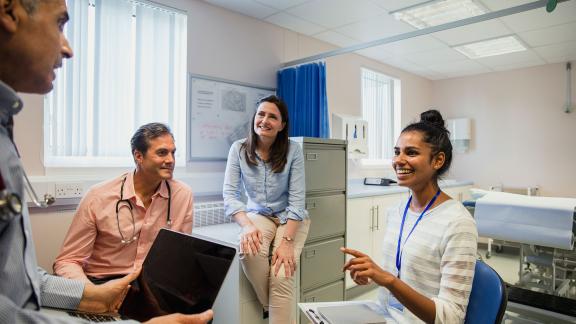Life Sciences Sector Plan: what you need to know
Key points
The Life Sciences Sector Plan (LSSP) is one of eight sector plans published as part of the government’s Modern Industrial Strategy, a ten-year plan to increase business investment and grow the industries of the future in the UK.
Developed in tandem with the Ten-Year Health Plan, the LSSP sets out how the life sciences sector can repair and transform the nation’s economy and health and play an enabling role in its shifts for the NHS, by accelerating the adoption of innovation in the NHS.
The plan aims to make the UK the most attractive place in the world to develop and deploy new treatments and seeks to make the UK one of the top three fastest places in Europe for patient access to medicines and medtech by 2030.
It sets out how the government will:
drive uptake of the most appropriate medicines and medical technologies
remove bureaucratic delays to patient access and reduce variation
introduce new low-friction procurement and contracting mechanisms for medtech to speed up access to new technologies support innovation by providing end-to-end funding for the implementation of disruptive innovations and local flexibility to be more radical and forward looking on innovation.
The sector plan is divided into three interconnected pillars, each requiring input and involvement from the health system:
Driving health innovation and NHS reform.
Enabling world-class research and development.
Making the UK an outstanding location in which to start, grow, scale and invest.
Our members will welcome the renewed focus on improving the uptake and widespread adoption of innovations on the NHS where cost effective and there is clinical need, as well as actions to support R&D and patient involvement in clinical trials.
While the LSSP sets out how the government will make efforts to grow the volume and quality of industrial science in the UK, its tangible impact will be limited if patients cannot get rapid access to the most clinically and cost-effective new technologies developed as part of these efforts and if healthcare leaders are not supported to deliver on the plan.

Published on 16 July 2025, the Life Sciences Sector Plan (LSSP) sets out the government's intentions to make the UK the most attractive place in the world to develop and deploy new treatments and to become one of the top three fastest places in Europe for patient access to medicines and medtech.
Overview
Published on 16 July 2025, the Life Sciences Sector Plan (LSSP) plan seeks to make the UK the most attractive place in the world to develop and deploy new treatments and by 2030, the UK will be one of the top three fastest places in Europe for patient access to medicines and medtech. This will be implemented in a way that supports the NHS, not strains it, achieved through close alignment with the government’s three shifts from hospital to community, from analogue to digital and from sickness to prevention.
The sector plan is divided into three interconnected pillars, each requiring input and involvement from the health system:
- Driving health innovation and NHS reform by ensuring patients get timely and rapid access to the most clinically and cost-effective new technologies and enabling the government’s three shifts.
- Enabling world-class research and development to take advantage and build on the UK’s scientific strengths.
- Making the UK an outstanding location in which to start, grow, scale and invest, to ensure ideas are built and scaled in the UK, the manufacturing sector is supported to thrive and the UK can drive foreign direct investment.
The government will focus its initial efforts in six headline areas that are seen as critical to the success of this strategy, to deliver demonstrable impact early on. This will be supported by the following additional commitments:
- Realising a health data research service, as committed to in April to create the world’s most advanced, secure and AI-ready health data platform to support and enable global trials and AI investment.
- Reducing clinical trial set-up times to under 150 days, through implementation of the O’Shaughnessy reforms and updated NIHR governance.
- Backing manufacturing with up to £520 million through the Life Sciences Innovative Manufacturing Fund.
- Streamlining regulation and market access by giving industry a clearer route to market through joint advice and parallel approvals between the Medicines and Healthcare products Regulatory Agency (MHRA) and NICE, alongside a route for international reliance for medicines and medical devices.
- Introducing low-friction procurement through a streamlined route to procurement, the introduction of a new innovator passport and rules-based pathway for medtech to enable products to reach patients quicker.
- Partnerships with industry to drive growth and innovation.
Plan delivery and accountability
The plan signals a new model of partnership between sciences and society; government and industry; and economic and health policy that recognises the relationship between better health and stronger growth. Alongside action at national level, the government will invest in place-based interventions including: continued investment in the 15 health innovation networks to strengthen their support for innovators; establishment of regional innovation zones for the implementation of innovation and continued support for life-sciences-focused investment zones.
The ambitions in the LSSP will be supported over the lifetime of the Spending Review by government funding of over £2 billion, alongside funding from UK Research and Innovation (UKRI) and National Institute for Health and Care Research (NIHR). The government will invest up to £600 million alongside the Wellcome Trust in the Health Data Research Service; £650 million over five years in Genomics England; up to £354 million in Our Future Health; at least £30 million into preclinical infrastructure linked to translational research networks; and up to £20 million in the UK BioBank.
To ensure successful implementation, and in a departure from previous life sciences plans, the LSSP takes an actions-focused approach, with each pillar supported by commitments, a metric to track progress and a named senior responsible officer (SRO). Progress will be reported through an annual implementation update and overseen by a bolstered Life Science Council made up of ministers and global life sciences industry leaders. The government has also established a ministerially chaired Life Sciences Delivery Board, bringing together public sector leaders to assess progress and drive delivery.
Partnership with devolved governments and mayoral strategic authorities (MSA) is also central to the plan’s delivery. MSAs will deliver ambitious ten-year local growth plans, with life sciences sector growth central to many of these plans. The Office for Life Sciences (OLS) will establish a new MSA life sciences working group to align local and national interventions for maximum impact and identify how to support life sciences focussed investable propositions. Mayors and strategic authorities are primary voices in developing and testing innovative new approaches to prevention. This presents an opportunity for NHS organisations to engage, providing a view of service delivery in parallel to the work of the MSAs.
Driving health innovation and NHS reform
While the LSSP sets out how the government will make efforts to grow the volume and quality of industrial science in the UK, its tangible impact will be limited if patients cannot get rapid access to the most clinically and cost-effective new technologies developed as part of these efforts and if system leaders are not supported to deliver on the plan. This aligns to the Ten-Year Health Plan’s commitments for health innovation to drive healthcare reform and focus on access and uptake through removing bureaucracy and barriers to adoption and spread, as well as delivering better outcomes for patients with a more modern, preventative healthcare system.
To accelerate the adoption of innovation in the NHS, the government will provide clarity to the sector and health system of core innovation priorities. This earlier signalling will ensure that investment, time and energy are targeted in the areas of highest impact. This will include priority areas of focus for the development and testing of innovations with transformational potential, but that require evidence on how they will be impactfully deployed, as well as areas where proven innovations will be prioritised for national scaling.
Focus is placed in two areas:
- Ensuring regulatory and market access systems get innovation to the NHS fast.
- Ensuring that all patients have access to clinically and cost-effective innovations through a reduction in unwarranted variation and clearer signalling of innovation priorities.
The plan makes the following commitments:
- Reduce unwarranted barriers to market entry for innovations through faster risk-proportionate and predictable barriers to market entry. This will be overseen by the chief executive of the MHRA and will ensure that systems have access to regulated products. This will be done through:
- creating a reformed medical devices regulatory framework that includes an innovation-friendly domestic route to achieving UK Conformity Assessment (UKCA) certification
- using international reliance and recognition routes to streamline the route to market for products that have previously sought comparator approval
- the MHRA aiming to be the fastest and quickest place to regulate AI and software, publishing a new framework for AI in 2026.
- Streamline market entry and ensure patients receive the most effective care, by ensuring NICE processes are timely, agile and transparent. This will include ensuring any future changes through NICE’s modular updates can be considered where they are evidence based and represent value to the taxpayer, and dynamic assessment of care pathways to provide certainty to clinicians on the most clinically and cost-effective care. This action will be overseen by NICE.
- To speed up adoption, the government will reduce friction in the system to optimise the uptake of new medicines. This will be overseen by the Director of Medicines, Value and Access at NHS England and will include:
- a new and proportionate approach to NICE appraisals and NHS indication-specific based pricing agreements for medicines with large numbers of indications, strong long-term outcomes data and low affordability of risk
- the roll out of confidential commercial pricing models in primary care in England
- the introduction of a Single National Formulary as set out in the Ten-Year Health Plan to remove bureaucratic delays to patient access, reduce prescribing variation and free up time to focus on caring for patients
- working with industry to accelerate growth in net spend on innovative medicines over the course of the plan.
- driving rapid uptake of biosimilars by working with local systems on implementation plans to support switching. This intends to allow for the NHS to deliver savings, which can be reinvested in newer medicines.
- Streamline access and adoption of medtech by reducing duplication and introducing low-friction procurement and contracting mechanisms. This will be overseen by the director of medical technologies at the Department of Health and Social Care (DHSC). As well as supporting innovators, this will enable systems to easily identify new innovations that have been assessed for clinical and cost effectiveness. As set out in the Ten-Year Health Plan, this will include the following:
- Implementation of the rules-based pathway for medtech, with associated reimbursement for proven medtech innovations, with support for adoption. Pilots for this programme will be launched by end of 2025. From April 2026, NICE’s technology appraisal process, which includes mandated funding by the NHS, will be expanded to cover some devices, diagnostics and digital products. There remains uncertainty on which products will be covered.
- Introduce a new NHS innovator passport for medtech by 2026 as set out in the Ten-Year Health Plan. Agreed national standards will enable better sharing of evaluation information and reduce duplication in local purchasing decisions. This will remove the need for repeated evaluations in each local health system. This is still in development but information that could be included in the passport includes Digital Technology Assessment Criteria (DTAC), Data Protection Impact Assessment (DPIA), value-based procurement and evidence validation requirements.
- Implement national standard guidance on value-based procurement for medtech and create new models for potentially high value innovations, including outcome-based procurement.
- For patients, create a new ‘HealthStore’ marketplace within the NHS App for patients to access approved health apps. Areas with tools that show significant promise include dermatology, physiotherapy and cognitive behavioural therapy for mental health conditions. These products will be funded from the centre and nationwide rollout will be piloted.
- Strengthen innovation metrics for medicines and Medtech through an updated innovation scorecard to monitor the uptake of innovations across England and enable targeted, tangible action at local and national level.
- Deliver the ambitions of the government’s Healthcare Goals programme across addiction, cancer, dementia, mental health and obesity with continued significant government funding. This will be overseen by the director of the OLS.
- As set out in the Ten-Year Health Plan, the government will establish regional health innovation zones for devolved demonstration of total healthcare system reform for scale-up across the health and care system. Starting in a small number of regions, the zones will act as exemplars for radical decentralisation and devolution. They will be empowered by devolutionary freedoms including to redesign services and work with industry more productively. They will also have the means to experiment with new commissioning models and simplify procurement. Health innovation networks and other existing innovation infrastructure across the region will work with and support their regional innovation zones. these will be overseen by the national director of transformation at NHS England.
Enabling world-class research and development
The UK has historic strength in R&D and this sits at the heart of its competitiveness in global life sciences. However, it is widely accepted that the UK could drive significant globally mobile investment by speeding up trial set up and delivery, realising the UK’s health and genomic potential, creating clear alignment on research priorities across industry and the NHS and ensuring systems are supported to deliver clinical trials. This would in turn release value to the NHS, with the ABPI estimating that on average in 2022/2023, NHS trusts were paid £26,311 per patient enrolled in commercial interventional trials.
The focus on clinical trials builds on the commitments announced in the ten-year heath plan to speed up clinical trials and encourage clinical trial participation through the NHS App. The plan commits to the following:
- Cut bureaucracy and standardise contracts to reduce the set-up time for commercial intervention clinical trials, reducing approval times to fewer than 150 days by March 2026. Performance data will also be provided to the NHS on trust-level clinical trial performance, split between commercial, academic, interventional and observational trials. Clinical trials capacity will also be expanded via funding from the VPAG investment programme (Voluntary Scheme for Branded Medicines Pricing, Access and Growth). This will be overseen by the chief scientific adviser at the DHSC.
- Build new infrastructure that increases the speed and scale of real-world evaluations of AI to enable AI tools to move out of pilot phase. This will start with AI in screening pathways and will be overseen by the DHSC’s chief scientific adviser. This supports commitments in the Ten-Year Health Plan to leverage the potential of AI by rolling out validated AI diagnostic and administrative tools from 2027.
- The previously announced Health Data Research Service (HDRS) will be established to make national population-scale data assets available for industrial and academic researchers. Delivery in 2025 will be focused on service set up with a chief executive and chair for the board appointed by autumn 2025 and the new entity up and running by 2026. By 2030, the HDRS will provide timely access and a single point of entry to the breadth of the UK’s general practice, hospital episode, prescribing/dispensing and death registration data covering the whole population, with AI-ready datasets including linked pathology, radiology and genomic data. This will be overseen by the chief executive of the HDRS (once appointed).
- Speed up access to health data for research and other secondary purposes through a combination of policy and legislative change, to streamline governance processes to maintain core safeguards while operating more efficiently. Cybersecurity principles will be embedded within the process to reinforce core safeguards. This focus is welcome as cyber security was absent from the Ten-Year Health Plan. By the end of 2027, the government will build on public engagement and work with the system, including clinical staff, to move to national and regional models of decision-making for access to all NHS data for secondary uses. This will be overseen by the director of the Joint Digital Policy Unit.
- Expand the UK’s health research data sets. By 2030, Our Future Health will have become the largest longitudinal health research cohort and clinical trials in the world, with up to five million consented participants with linked primary and secondary health data. By 2030, the UK Biobank will have expanded the impact of its biomedical research resource with enhanced characterisation of participants and Genomics England will have one of the largest genomics research databases in the world with over 500,000 participants. The NHS Genomic Medicine Service will work with industry, academia and other partners through NHS Genomic Networks of Excellence to generate evidence and models of adoption for genomic innovations and specific areas.
- To align with the government’s prevention shift, government will shift investment in health R&D to focus on primary and secondary prevention and the treatment of physical and mental long-term conditions. This will be overseen by the chief scientific adviser, DHSC.
- The government will update NIHR’s governance model and require it to work to a dual health and growth mandate, driving focus on activity which is growth-maximising alongside improving health outcomes. This will be overseen by the chief scientific adviser, DHSC.
Making the UK an outstanding place in which to start, scale and invest
The plan recognises that the UK’s offer for those looking to scale and invest in life sciences has been internationally uncompetitive. It commits to action in five areas including access to finance; skills through improving the quality and quantity of training; manufacturing through the Life Sciences Innovative Manufacturing Fund; net-zero through implementation of the NHS Net-Zero roadmap; and high-value strategic partnerships. A focus in these areas will in turn ensure UK patients can access the latest innovations and take part in work leading research.
Analysis
There is much to welcome in the sector plan. Having a thriving UK life sciences and innovation sector is key to ensuring patients get access to the treatments they need, at the best value to the health system. While the ambitions in the plan to enable world-class R&D and drive health innovation and NHS reform are welcome, these cannot be realised without clear alignment with the NHS Ten-Year Health Plan delivery, as well as engagement with health leaders. It is therefore positive that this sector plan recognises the need for complete alignment between objectives and means of delivery of the LSSP and Ten-Year Health Plan and provides some additional detail on Ten-Year Health Plan innovation commitments, including the innovator passport, timelines for value-based procurement, engagement around the Single National Formulary and HDRS.
Our members will welcome the renewed focus on improving the uptake and widespread adoption of innovations on the NHS where cost effective and there is clinical need, as well as actions to support R&D and patient involvement in clinical trials.
If implemented in full, the recommendations in the plan will make it easier for NHS organisations to procure, access and fund medical technology through the implementation of the rules-based pathway for medtech and innovator passport; to signal their priorities back to government and industry; to monitor medicines uptake and be supported to develop new service models and pathways to enable new innovations. We now await clarity on how health leaders will be consulted on the development of these initiatives to ensure they can deliver for both the system and the sector.
Also welcome is the inclusion of patient-facing initiatives including the HealthStore to enable access to approved health apps to manage or treat their condition. It is positive to see initiatives that help people manage their own health and respond early if they need help. This must be co-designed with patients, healthcare professionals and industry partners to ensure it is easy to use, fit for purpose, safe, aligned to need and evidence based. The HealthStore must also be aligned to plans for the NHS App, with clarity on how people will be supported to access and use it. These tools must supplement and complement available NHS services and should not be seen as an alternative where not sufficient for people’s needs.
As the plan is implemented, consideration must be given to the long-term implementation of innovations into business-as-usual practice and overcoming barriers to adoption, including addressing challenges with digital and data infrastructure and ensuring availability of funding to support implementation and pathway design - a concern we hear regularly from members.
Reducing variation in medicines access and uptake is a key part of the plan. One of the most significant announcements is the decision to move away from local formularies to one single national formulary to minimise duplication, enable consistency in prescribing, support uptake and equity of access and streamline decision-making. NHS leaders know that, currently, too many patients with similar conditions might have different eligibility for the same medicines depending on where they live. This creates administrative challenges, not to mention ethical issues associated with disparities in care in a universal healthcare service.
A Single National Formulary (SNF) could free up more of local teams’ time to improve care and reduce variation, as the NHS Confederation first proposed in 2021. It can also speed up the introduction of effective and cheaper generic and biosimilar medicines, allowing money to be reinvested in patient care and getting better value for taxpayers' money. The introduction and management of the SNF will need to be carefully handled, ensuring that it does not become a bottleneck for decisions and that it routinely benefits from the insights of NHS staff on the front line. While the plan references close working with industry on the SNF, we would call for the views of NHS leaders, including medicines optimisation leads and chief pharmacists, to be considered as part of engagement.
How we will be supporting members
- We will continue to engage with the Office of Life Sciences, and other SROs involved in the plan on behalf of members to support the development of additional detail on implementation to ensure the experiences of health leaders are factored into implementation.
- The publication of the LSSP comes at a pivotal time for the life sciences sector, as negotiations continue between industry and the government around the VPAG and negotiations continue around US/UK trade tariffs for pharmaceuticals and devices. NHS Confederation is closely monitoring these developments and will keep members updated on any potential impacts on medicines supply and pricing as this evolves.
NHS Confederation’s work in innovation and life sciences continues to focus on supporting the adoption, scaling and implementation of medtech, medicines, particularly those in prevention and AI, and fostering effective industry/NHS partnerships, through implementation of our practical guidance with the ABPI
Further information
For further information on NHS Confederation’s work across innovation and life sciences or to discuss what these developments mean for you, please contact Alice.Inch@nhsconfed.org, senior policy adviser for innovation and life sciences.



